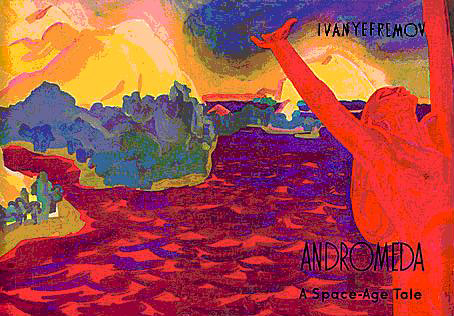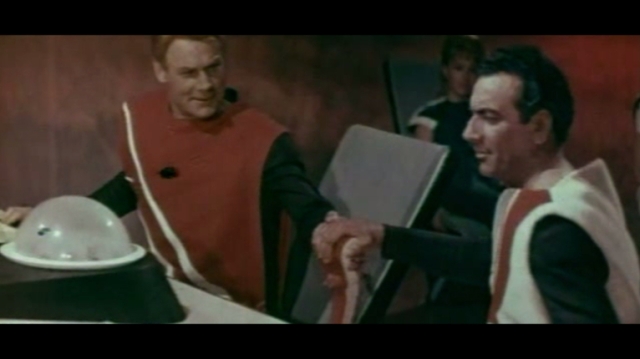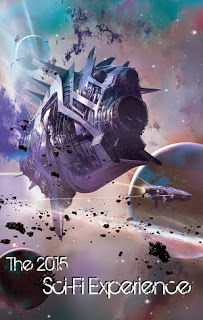Andromeda: A Space-Age by Ivan Yefremov (aka ‘Efremov’) was first published in 1957 as Туманность Андромеды (Tumannost’ Andromedy — Andromeda Nebula). The English language edition was first published in 1959. A new English language translation has recently been published.
Many consider Andromeda a pivotal work of science fiction produced in the Soviet Union — for instance the brothers Strugatsky. The first third of the novel was turned into part one of a projected three part film in 1967. No further parts were made.
Published at the beginning of the ‘thaw’ in the Khrushchev era, Andromeda is a modern utopia about a post-capitalist society one thousand or so years into the far future. The people of this society have made contact with extra-terrestrials via a long distance communications network known as ‘the Great Circle’. In the novel the Great Circle pre-exists human contact. Three hundred or so years after the end of capitalism and some 700 odd years before the events of the novel the humans of Earth made contact with the Great Circle — an achievement made possible by the powerful engines, receivers and transmitters of a planetary society rationally organised in a post market fashion. In Yefremov’s utopia the activities with which most humans are creatively engaged are scientific research and artistic expression. The material necessities of life are produced by automatic machinery, or by the targeted use of human labour in industrial areas not completely automatized. The latter activities are voluntarily organised and are often conducted on a temporary basis in-between the more usual scientific and artistic activities.
Yefremov’s story has three main narrative threads: the story of the space ship ‘Tantra’ and its visit to two worlds, in particular its strange visit to the planet of an ‘Iron Star’; the story of the world weary Darr Veter and the archaeologist Veda Kong; and the story of Mven Mass and his ill-advised experiment in Zero Transportation. All three tales intersect but only that of the ‘Tantra’ spends the first half of the novel far off in deep space.
The novel opens with the story of the space ship ‘Tantra’, sole vessel of the ‘37th Cosmic Expedition’. Led by the experienced astronaut Erg Noor, the crew of the ‘Tantra’ are returning to Earth from the planet Zirda. On their return the ship is deflected by the massive gravitational force of the previously unknown Iron Star. Forced to land on one of the star’s planets the ‘Tantra’ is faced with the grim fact of the exhaustion of its ‘anameson’ fuel. What follows is fairly standard SF fare with the discovery of dangerous electrical creatures, the ancient wreck of an alien spacecraft and the solution to the mysterious disappearance of a previous Cosmic Expedition. Amidst it all Erg Noor even negotiates the difficult and exhilarating emergence of a love affair.
In his description of spaceflight Yefremov scrupulously stuck to the perceivable limits of science fact, rather than the science fantasy of FTL travel and ‘hyperdrives’. In doing so he was able to harness the inherent tensions of these limits — even though he provides his ships with the capacity of 5/6th of light speed via the fantastical if not completely unbelievable fuel ‘anameson’. The crew of the ‘Tantra’ are effectively cut-off from help from Earth, and back on Earth the delayed return of the vessel proves troubling.
Of the three narrative threads the story of Darr Veter and Veda Kong was the least interesting, though the idea of Darr Veter being beset by a world-weary apathy in the midst of the abundance and adventure of the future was intriguing (at least in its set-up). In the film Darr Veter spends most of his time with a bemused look on his face — perhaps a failing of the actor rather than the smirk of existential weariness. In both the novel and the film he has just resigned as Earth’s director of communications with the Outer Stations of the Great Circle, having passed on the role to Mven Mass. Darr Veter is thus freed to follow Veda Kong to an archaeological dig and further into the world of the socialist future. He provides good work as a wanderer at a loose end, between jobs — the perfect analogue of Virgil in future communist garb. Of course he regains his resolve toward the end of the novel after Mven Mass’ experiment and exile to the Island of Oblivion.
The story of Mven Mass and the experiment in Zero Transportation is one of the best parts of the novel. Inspired by the strange and alluring vision of the almost human figures dancing in a recent recording received from Epsilon Tucanae along the Great Circle — and represented on the book’s cover above — Mven Mass is overwhelmed by the fact that he will never meet those who sent the recording, 300 years gone. Too far to be reached by the current sub-light ships of Earth, he sets out to organise an experiment in Zero Transport (i.e. matter transportation, spatial folding, whatever). Enrolling the physicist Ren Bose, and against the advice of his good friend Darr Veter, Mven Mass oversees the experiment. Of course it all ends in tears with a scene of a fucked up fold in the space-time continuum worth the price of admission alone. As a form of atonement and despair Mven Mass exiles himself to the Island of Oblivion. Here go various people who have decided permanently or in passing that they do not fit into the socialist utopia.
The Island of Oblivion (Sri Lanka) plays an interesting role in Yefremov’s science fiction utopia. Unlike the rest of the planet the people of the island do not self-organise collectively — they are variously hermits or exist in small bands. In some ways it resembles a vast open air psychiatric park, its denizens turned away from the benefits of meaningful work and the social compact of the encircling socialist society. Here selfishness and self-obsession exist alongside of despair and exhaustion. In the only disturbing encounter on the island Mven Mass interrupts and stops what amounts to a rape gang led by a brilliant though severely troubled mathematician in exile. The resolution of both this and Mven Mass’ exile comes too quickly and unconvincingly as Yefremov struggled to present the Island as a rational way to deal with those so ‘afflicted’, beyond the scope of coercion and humiliation.
The novel itself is sometimes didactic but nothing worse than the many Western science fiction novels published at the same time (I am looking at you Robert Heinlein). Indeed it shares the sometimes mystical technological optimism of its day and projects a utopia not dissimilar to the machine automated futures promised throughout the industrial worlds of the 1950s and 60s — capitalist or “socialist”. Yefremov even included a veiled critique of Stalin and Stalinism. When two of the central characters, Darr Veter and Veda Kong, find themselves briefly marooned on the steppes after the gentle crash of their air transport, Stalin is encountered in the form of a stray bull at night — though not so much a mare as a night bully leering out of the metaphorical dark. Sadly Yefromov’s critique goes no further than this. Considering the publication year of the novel this is perhaps not too unusual. The year before, 1956, saw the Poznań uprising in Poland and even the reappearance of working class revolution against the Soviet monolith in Hungary itself. The same year saw Khrushchev deliver his ‘secret speech’. His limited criticism of the ‘Stalin cult’ was soon mirrored in Yefremov’s bullish analogy.
Aspiring to be both utopian and distinguished from the recent horrors of the Stalinist past, Yefremov strived to present a world that did some justice to the socialist imaginary of the 19th and 20th centuries. The world is apparently without a central authority even though there are authorities — various Institutes and Councils that are democratically organised by their participants. The Institutes appear to be organised on lines similar to the present University sector, though more in keeping with the medieval ideal of the scholastic guild organised by students and teachers. The Councils on the other hand appear as the clearest analogues of state bodies, though they have more in common with the revolutionary origins rather than the then present reality of the Soviet state.
The most ‘state-like’ authority we have contact with in the novel is the ‘Astronautical Council’. One of many interlocking Councils responsible for the self-governance of the future utopians, the Astronautical Council coordinates space exploration and ultimately the Earth’s dealings with the Great Circle civilisations. For instance Mven Mass, the sometime Director of the Outer Stations, is answerable to this Council, as too is Erg Noor and the 37th Cosmic Expedition embodied by the ‘Tantra’ and its crew. Markedly there is a complete absence of any explicit coercive authority; for instance there are no armies or police. Even the renovated state socialism of the Khrushchev period continued to lay hold of the idea of the ‘withering of the state’, though largely as a religious-like dogma in the midst of its vast and labyrinthine state bureaucracy.
One obvious reference to the contemporary politics of the 1950s comes in the form of an early passage regarding the original destination of the ‘Tantra’ expedition — the planet Zirda. Upon arrival the crew of the ‘Tantra’ found a dead world, the result of ‘careless experiments and the reckless use of dangerous forms of nuclear energy’ (21). Zirda plays the role of a science fictional parable of the nascent atomic age. The obvious target is the United States and her allies, but there is no reason why Russian readers of Yefremov could not have pictured in its place the so-called ‘responsible’ nuclear program of the Soviet ruling class. Indeed the claims made by the Russian, American and British ruling classes in the late 1950s were in effect identical, with the emphasise on the peaceful application of nuclear power all the better to disguise the truth of their rapidly accumulating atomic arsenals. Nonetheless the brief descriptions of Zirda, the dead world left in the wake of an industrialism gone wrong, contain real emotional power.
Some reviewers of Andromeda have remarked on the crazy grand climate engineering that has been carried out on Yefremov’s Earth, and without doubt such schemes raise an eyebrow or two these days. This novel was written in the days when Khrushchev dreamt of using atom bombs to change the course of rivers for mass agricultural purposes. And yet the idea of a rational transformation is not entirely fanciful if we consider that the current industrial transformation of Earth is not rational. Certainly the ruling caste of the Soviet Union claimed the mantel of rationality and ‘socialism’, but it is arguable if such claims ever matched the bureaucratic reality of life in Russia.
Though Andromeda can sometimes come across as didactic, especially the sections involving the travels and travails of Darr Veter, there is still much of interest here. Yefremov was keen to show, against his conception of Western science fiction (of which he was an avid reader under difficult conditions of access) the possibility of representing a future that was more than just the displaced reality of 1950s Earth. He is partially successful, on the one hand representing a society that is in many ways immanently critical of his own Soviet society, while also presenting a utopian project of the Soviet ideal. Indeed he even later criticised the Strugatsky brothers for giving ‘their heroes […] typically human positive traits, passions and shortcomings and then artificially push[ing] them back into a distant future’, rather than exploring the possibility that future men and women would ‘belong to an absolutely different race – their woes are not our woes and their joys are not our joys; therefore to some they may seem odd and unnatural’.
As already touched on above the book was, and still is considered very significant for ‘modern’ science fiction in Russia. Under Stalin and the ‘close aim’ doctrine science fiction resembling the burgeoning Golden Age SF of the West was effectively banned. Andromeda succeeded in not only ending this ban, but presented a model of SF that managed to inspire the (re)birth of the genre in late 1950s Russia. For instance Boris Strugatsky, one of the more famous exponents of modern Soviet SF in the West, drew attention to Yefremov’s singular place in the cultural thaw and rebirth of SF in Russia:
the publication of Andromeda became a symbol of the new era, its banner, in some sense. Without it, the new growth would have been an order of magnitude more difficult, and a thaw in our SF wouldn’t have come until later.
Indeed the Strugatsky brothers ‘Noon Universe’ is impossible to imagine without the appearance of Yefremov’s Great Circle universe. No doubt the Strugatsky brothers became more capable writers than he, definitely more able and subtle in their characterisations and ultimately more critical of the Soviet ideal. And yet Yefremov himself moved in a similar, critical direction, as did many of the intellectual and middle class supporters of the ‘thaw’ in the wake of the fall of Khrushchev and the creeping frost of Kosygin and Breshnev’s reign in the mid-1960s. In 1968 Yefremov returned to his Great Circle universe in the novel Hour of the Bull (Час Быка, Chas Byká). If we remember Yefremov’s typification of Stalin as literally a bully, the title should alert us to his more critical intent. Though not the Soviet censors who initially passed the book for publication and then removed it from official distribution when they found behind its caricature of the Maoist-like bureaucrats the real target: themselves!
One of my favourite Strugatsky brothers’ stories, Far Rainbow, can be considered a sort of response to Andromeda. Written within their own communist utopian future, it is a melancholic tale about the failure of a Zero Transport experiment. It plays an interesting role in the Strugatsky’s works, the first step toward their much darker fictionalised critique of the claims of Marxism-Leninism, Hard to Be a God. Hopefully I will return to review both this work and Far Rainbow in the not too distant future.





That idea of enjoying doing science in a better society got lost after the 1960s, where various forms of free play were taken on as the sole goal (including supposedly playful theory!). You’re right to revive interest in classless science, as is clear if indeed untrammeled scientific activity could help erase today’s legacy. of environmental destruction. In my view all radicals should promote the promise of science without social power.
Pingback: Vintage Month Comes to a Close | the Little Red Reviewer
Pingback: The science fiction spectacle (2) | the sinister science
Pingback: SF in the SI: science fiction, ideology and recuperation | the sinister science